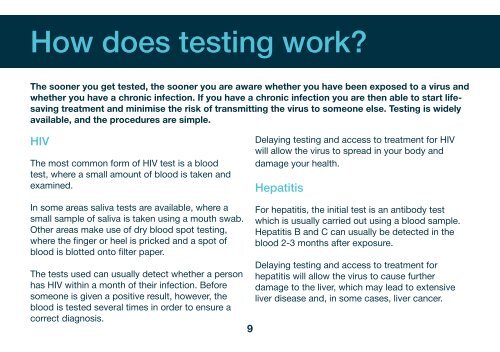European HIV-Hepatitis Testing Week 2016
You also want an ePaper? Increase the reach of your titles
YUMPU automatically turns print PDFs into web optimized ePapers that Google loves.
How does testing work?<br />
The sooner you get tested, the sooner you are aware whether you have been exposed to a virus and<br />
whether you have a chronic infection. If you have a chronic infection you are then able to start lifesaving<br />
treatment and minimise the risk of transmitting the virus to someone else. <strong>Testing</strong> is widely<br />
available, and the procedures are simple.<br />
<strong>HIV</strong><br />
The most common form of <strong>HIV</strong> test is a blood<br />
test, where a small amount of blood is taken and<br />
examined.<br />
Delaying testing and access to treatment for <strong>HIV</strong><br />
will allow the virus to spread in your body and<br />
damage your health.<br />
<strong>Hepatitis</strong><br />
In some areas saliva tests are available, where a<br />
small sample of saliva is taken using a mouth swab.<br />
Other areas make use of dry blood spot testing,<br />
where the finger or heel is pricked and a spot of<br />
blood is blotted onto filter paper.<br />
The tests used can usually detect whether a person<br />
has <strong>HIV</strong> within a month of their infection. Before<br />
someone is given a positive result, however, the<br />
blood is tested several times in order to ensure a<br />
correct diagnosis.<br />
9<br />
For hepatitis, the initial test is an antibody test<br />
which is usually carried out using a blood sample.<br />
<strong>Hepatitis</strong> B and C can usually be detected in the<br />
blood 2-3 months after exposure.<br />
Delaying testing and access to treatment for<br />
hepatitis will allow the virus to cause further<br />
damage to the liver, which may lead to extensive<br />
liver disease and, in some cases, liver cancer.



